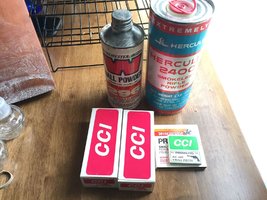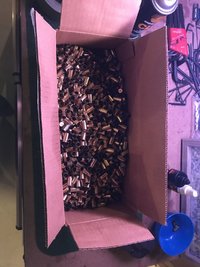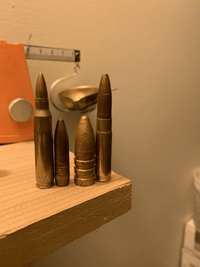I use the Weldon bit all the time with .223/5.56. I haven’t had issues with it.I don't think it'll work in the tiny small primer pockets of 5.56/.223.
-
If you enjoy the forum please consider supporting it by signing up for a NES Membership The benefits pay for the membership many times over.
You are using an out of date browser. It may not display this or other websites correctly.
You should upgrade or use an alternative browser.
You should upgrade or use an alternative browser.
What did you do in the reloading room recently?
- Thread starter DW357
- Start date
I loaded some 230 grain .45 with 3.9 grains of Clays and 147 grain 9mm on 3.4 grains of n320. The 9mm is my usual recipe with xtreme and some new blue bullets I'm trying for the second time.
I chrono the loads today, the .45 was way short of major. Out of my TRP I got an avg 640. Pf 147000. That's almost max too, may switch maybe to wst.
Found this in regards to clays, 230 gr, and power factor
May or may not be useful to you-
.jpg.d2ca5690cc27d62ab196f9f1f52585c4.jpg)
Experience with Clays in .45 ACP?
I just started experimenting with Clays and am looking for some insights. I weighed 4.0 grains (the max charge per Hodgdon) behind an X-Treme 230 grain plated round nose. Out of a 5” Wilson CQB, a 10 round string averaged 717 fps which just makes 165 PF. Four of the 10 rounds chrono’ed under 717 ...
forums.brianenos.com
Inhated the super swager. Sold it after one session. Unless the brass is from the same lot, you will have a bunch of rounds with primers not seating all the way. I have an ammo can full of high primered cases that I have to pull apart and use the weldon but on.
I use the Weldon bit all the time with .223/5.56. I haven’t had issues with it.
yeah, thanks.
i checked for myself earlier this morning and realized i had never tried it before.
I transferred the 296 to an empty plastic 296 bottle I had just to examine the powder. There was one clump of powder that fell apart easy when I poked it with a cleaning rod. It smells exactly like the new 296 powder I have so I think it’s okay. I suspect maybe just static from being in the metal can?Picked up some powder and primers from fellow NESer LenS.
I think these components are older than me
I was amazed how compact the primer packaging was.
View attachment 345157
Quite_Exasperated
NES Member
- Joined
- Feb 26, 2020
- Messages
- 2,796
- Likes
- 5,321
Life is good fellas, just realized I have a callous on my press handle hand from making so much ammo!
Should be a date on the bottom if the can. IIRC “hercules” branded powder went out in the 80s maybe 90sPicked up some powder and primers from fellow NESer LenS.
I think these components are older than me![Laugh [laugh] [laugh]](/xen/styles/default/xenforo/smilies.vb/012.gif)
I was amazed how compact the primer packaging was.
View attachment 345157
Bought out entirely in 08 by ashland
I did a lot of smokeless powder throne research a while back when I found out how little smokeless powder is made here in the states
Looks like 1991 for the 296 powder. It was a little darker colored than the new 296 I have but aside from that it looks and smells the same.Should be a date on the bottom if the can. IIRC “hercules” branded powder went out in the 80s maybe 90s
Bought out entirely in 08 by ashland
I did a lot of smokeless powder throne research a while back when I found out how little smokeless powder is made here in the states
I just finished loading all 800+ Speer 240 gr FMJ FN silhouette bullets. I need to take a break for a bit
Mudflap621
NES Member
- Joined
- Jan 24, 2019
- Messages
- 1,122
- Likes
- 2,636
FedEx just delivered 1k 38 cal 158 gr Zero bullets. Silly me I meant to order JHPs but accidentally ordered JSPs...darn. Didn’t notice until I opened the box.
First world problems....
First world problems....
I drained my casting pot of some alloy I got on a deal with WEGMAN really nice harder stuff than I need so I will reserve it for later use. Im going to assume the gent he got it from shot 38 super and used hardball ? Cast nice bullets but I can use less expensive alloy and water quench for hardness.
Started a pot of my Faux Lyman # 2 10lbs wheel weights and .4 lbs pewter----I have a good amount of pewter and this blend works well
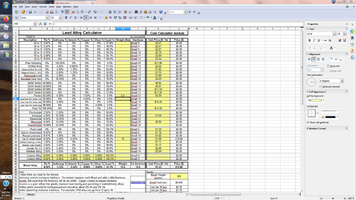
Started a pot of my Faux Lyman # 2 10lbs wheel weights and .4 lbs pewter----I have a good amount of pewter and this blend works well

38ExtraSpecial
NES Member
I drained my casting pot of some alloy I got on a deal with WEGMAN really nice harder stuff than I need so I will reserve it for later use. Im going to assume the gent he got it from shot 38 super and used hardball ? Cast nice bullets but I can use less expensive alloy and water quench for hardness.
Started a pot of my Faux Lyman # 2 10lbs wheel weights and .4 lbs pewter----I have a good amount of pewter and this blend works well
View attachment 345220
Wow thats a lot of tin. What is the purpose of so much tin?
I was given some Lyman #2 years ago and really liked how it casted , im a CFSF so I dont buy known alloys. So I make a close enough good enough. Faux #2Wow thats a lot of tin. What is the purpose of so much tin?
Im not all that good with pictures (Iphone 5s) Im not sure ig the details shows up?
LH bullet is the "hard" alloy. It definitely is more shiny to the eye you can also see the LH bullet is not as squared or defined as the RH bullet with the Faux lyman # 2
Lyman says this mold should drop 133 grains with Lyman #2
LH bullet drops at 129 grains my RH Faux alloy drops at 133.7
I think the LH bullet alloy has more Antimony closer to hardball or even linotype---I will set this aside until I can actually test the Bhn or find someone with one of those Xray gun analyzers and get a alloy read out. I will reserve any "hard" alloy for the higher pressure rounds. Even for this bullet my Faux#2 is probably to hard.
Im running mouse fart loads out of my 38spl maybe 13,500 psi I could easily get away with straight COWW or even range scrap. Now with this hard alloy I could probably run some hot 30 cal rifle loads and even hotter still water quenched. Im going to work up a cast load that works for my M1a and I think this hard alloy will help get me there
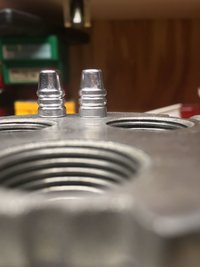
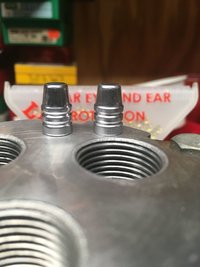
Last edited:
im a CFSF so I dont buy known alloys.
CFSF?
You're talking black magic on some of this. Is antimony for vampires, or werewolves?
Also, those are shiny. I am NOT going to start casting bullets. Too many projects already...
Last edited:
38ExtraSpecial
NES Member
Understood. I’ve never used certified alloys so I can’t speak to how well they cast or shoot. However @1919FAN makes some rich alloy that does shoot amazing.I was given some Lyman #2 years ago and really liked how it casted , im a CFSF so I dont buy known alloys. So I make a close enough good enough. Faux #2
Im not all that good with pictures (Iphone 5s) Im not sure ig the details shows up?
LH bullet is the "hard" alloy. It definitely is more shiny to the eye you can also see the LH bullet is not as squared or defined as the RH bullet with the Faux lyman # 2
Lyman says this mold should drop 133 grains with Lyman #2
LH bullet drops at 129 grains my RH Faux alloy drops at 133.7
I think the LH bullet alloy has more Antimony closer to hardball or even linotype---I will set this aside until I can actually test the Bhn or find someone with one of those Xray gun analyzers and get a alloy read out. I will reserve any "hard" alloy for the higher pressure rounds. Even for this bullet my Faux#2 is probably to hard.
Im running mouse fart loads out of my 38spl maybe 13,500 psi I could easily get away with straight COWW or even range scrap. Now with this hard alloy I could probably run some hot 30 cal rifle loads and even hotter still water quenched. Im going to work up a cast load that works for my M1a and I think this hard alloy will help get me there
View attachment 345270View attachment 345271
I’ve always been under the impression that Lyman#2 and similar hard alloys are a result of the industrial bullet casters that can’t water quench bullets the way us hobby casters do.
I’m sure of the commercial guys could find a way to use a less expensive alloy and quench to get the same results they would.
COWW can be water dropped or heat treated up to about any hardness you could possibly need. Nullifying the need for these expensive rich alloys which will air cool to similar hardness.
Old timer I learned a lot from said that commercial casters use hard alloys, generally a lot harder than you need. 22-2BHN for everything and also use Hard lube. All in the name of keeping the bullets pretty ( no dings and dents when shipping) and the lube in place. Ever go down range and find a bullet unscathed with lube grooves still full to the brim ?Understood. I’ve never used certified alloys so I can’t speak to how well they cast or shoot. However @1919FAN makes some rich alloy that does shoot amazing.
I’ve always been under the impression that Lyman#2 and similar hard alloys are a result of the industrial bullet casters that can’t water quench bullets the way us hobby casters do.
I’m sure of the commercial guys could find a way to use a less expensive alloy and quench to get the same results they would.
COWW can be water dropped or heat treated up to about any hardness you could possibly need. Nullifying the need for these expensive rich alloys which will air cool to similar hardness.
He said IF the bullet manufacture does not print on the box the Bhn they are running a hard alloy/ lube across their complete line. He said it also makes it easier on the commercial casting machines.
They do not water quench because its another step in the process. That guy was right I seldom see any cast bullet manufacture stating their bullet BHN. Some here along the line "hard cast" was the cry of the bullet makers and "hard" was better... I later found out he was a cast bullet manufacture when his magma engineering equipment went up for sale about 12 years ago, along with a boat load of Corbin swagging equipment....all way to expensive for me.
If you have a close idea of the chamber pressures of your loads ( some load data will have this) you can figure out what BHN you need so the bullet expands correctly.
a simple formula is your BHN X 1422 this is about the minimum chamber pressure for your alloy.
Now at some point I will need to get a BHN tester but I think with out a lot of work that alloy I recently got water quenched will get me into the low 20s for my 1900-2000fps loads in my M1a
It might explain why I just was not getting good accuracy with the garands with cast loads. I got 100% function but was getting 5 moa with some crazy flyers.
Last edited:
38ExtraSpecial
NES Member
I think you nailed it on the head.Old timer I learned a lot from said that commercial casters use hard alloys, generally a lot harder than you need. 22-2BHN for everything and also use Hard lube. All in the name of keeping the bullets pretty ( no dings and dents when shipping) and the lube in place. Ever go down range and find a bullet unscathed with lube grooves still full to the brim ?
He said IF the bullet manufacture does not print on the box the Bhn they are running a hard alloy/ lube across their complete line. He said it also makes it easier on the commercial casting machines.
They do not water quench because its another step in the process. That guy was right I seldom see any cast bullet manufacture stating their bullet BHN. Some here along the line "hard cast" was the cry of the bullet makers and "hard" was better... I later found out he was a cast bullet manufacture when his magma engineering equipment went up for sale about 12 years ago, along with a boat load of Corbin swagging equipment....all way to expensive for me.
If you have a close idea of the chamber pressures of your loads ( some load data will have this) you can figure out what BHN you need so the bullet expands correctly.
a simple formula is your BHN X 1422 this is about the minimum chamber pressure for your alloy.
Now at some point I will need to get a BHN tester but I think with out a lot of work that alloy I recently got water quenched will get me into the low 20s for my 1900-2000fps loads in my M1a
It might explain why I just was not getting good accuracy with the garands with cast loads. I got 100% function but was getting 5 moa with some crazy flyers.
Have you seen the threads on guys experimenting with copper in the alloy? It ads a touch more hardness but much more toughness. Almost like tin but more toughness. It’s allowing for faster velocities by strength not stripping the alloy in the rifling and also giving better toughness allowing for better expansion in harder alloys. So hollow points that can handle the father velocities with shattering (hard antimony alloy) or completely flattening out and acting like a parachute limiting penetration (soft pure or binary lead and tin)
I casted up some dead soft hollow points with a friends dad 150 grain 358 lyman mold. They would darn near fold back on themselves!I think you nailed it on the head.
Have you seen the threads on guys experimenting with copper in the alloy? It ads a touch more hardness but much more toughness. Almost like tin but more toughness. It’s allowing for faster velocities by strength not stripping the alloy in the rifling and also giving better toughness allowing for better expansion in harder alloys. So hollow points that can handle the father velocities with shattering (hard antimony alloy) or completely flattening out and acting like a parachute limiting penetration (soft pure or binary lead and tin)
IIRC COWW heat treated at 430-450' F for 1 hr can get to about 20 after a week of hardening ?I think you nailed it on the head.
Have you seen the threads on guys experimenting with copper in the alloy? It ads a touch more hardness but much more toughness. Almost like tin but more toughness. It’s allowing for faster velocities by strength not stripping the alloy in the rifling and also giving better toughness allowing for better expansion in harder alloys. So hollow points that can handle the father velocities with shattering (hard antimony alloy) or completely flattening out and acting like a parachute limiting penetration (soft pure or binary lead and tin)
When you hitek coat your bullets would that not soften them if you dont quench them ?
38ExtraSpecial
NES Member
I could imagine. I’ve shot some pretty soft stuff chugging along out of a snub by with good results. I’m dying to try a longer barrel to see how they work.I casted up some dead soft hollow points with a friends dad 150 grain 358 lyman mold. They would darn near fold back on themselves!
Correct. If I need extra hardness for the application then I will quench the bullets after my last coat is done baking. Drop the whole tray right into cold water. Just like heat treating or water dripping make sure you size then right away before they age harden.IIRC COWW heat treated at 430-450' F for 1 hr can get to about 20 after a week of hardening ?
When you hitek coat your bullets would that not soften them if you dont quench them ?
hv55maxx
NES Member
View attachment 345372
500gr cast for 458 socom subsonic,
Where does one hunt dinosaurs these days?
That thing is huge
Wowza! That's a lot of lead!View attachment 345372
223, Lee 230gr cast (hi-tek coating overcooked- oops), 500gr cast for 458 socom subsonic, 300blk loaded with 230gr cast.
I chose gold for the hi-tek coating but in the first run (230gr projos) apparently you can overcook it to discoloration.
I can only imagine how expensive jacketed bullets are for 458...
$1 each min , $1.50 av theres a company that makes all copper ones for silly $$Wowza! That's a lot of lead!
I can only imagine how expensive jacketed bullets are for 458...
hv55maxx
NES Member
buck a piece or more for projos. ~4 pounds of lead for 60 projectiles ![ROFL [rofl] [rofl]](/xen/styles/default/xenforo/smilies.vb/013.gif)
![ROFL [rofl] [rofl]](/xen/styles/default/xenforo/smilies.vb/013.gif)
hv55maxx
NES Member
Wowza! That's a lot of lead!
I can only imagine how expensive jacketed bullets are for 458...
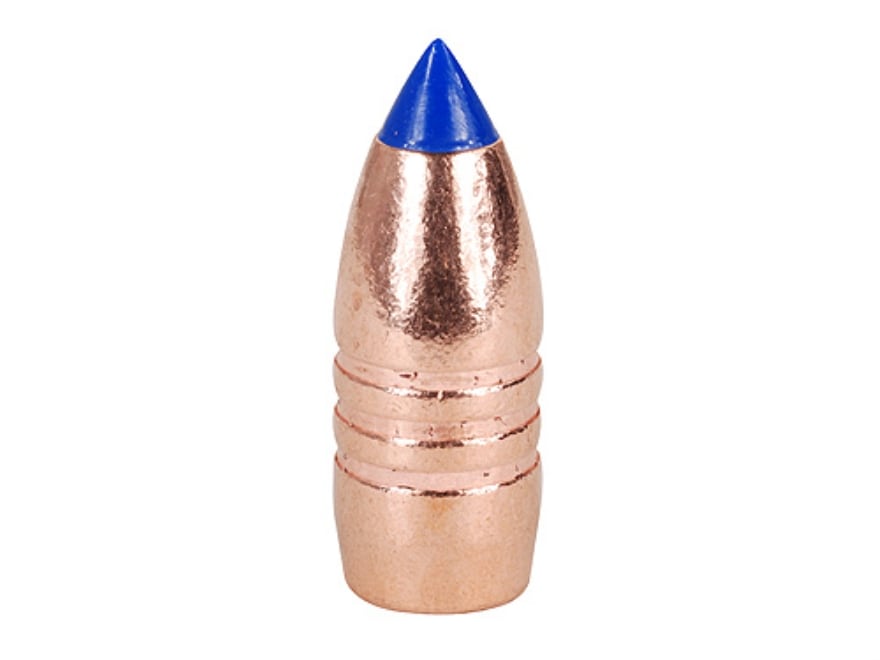
Barnes Tipped Triple-Shock X (TTSX) Bullets 458 SOCOM (458 Diameter)
The Barnes Tipped TSX features a 100-percent copper body with rings cut into the shank. A polymer tip boosts the ballistic coefficient, improves...
xtry51
NES Member
TTSX are no joke. They hit hard and I've yet to find a hunting round as accurate and devastating in .308.
View: https://youtu.be/nV8ij1gK-ck
99% energy transfer in 24" of ballistic gell with 100% weight retention.
Worth every penny they charge for them.
View: https://youtu.be/nV8ij1gK-ck
99% energy transfer in 24" of ballistic gell with 100% weight retention.
Worth every penny they charge for them.
those are only 300gn!
Barnes Tipped Triple-Shock X (TTSX) Bullets 458 SOCOM (458 Diameter)
The Barnes Tipped TSX features a 100-percent copper body with rings cut into the shank. A polymer tip boosts the ballistic coefficient, improves...www.midwayusa.com
hv55maxx
NES Member
those are only 300gn!
thats what i've been loading in my pre-casting era. bark flies wildly off the tree at my friends house when we shoot there.
Loaded up 158gr Zero JHPs over N110, with charges from 14.0 to 15.0 grains. I'd previously only loaded 15.0 grains, which is actually below the VV starting charge, but it seemed rather hot and gave a pretty impressive (though not out of expected range) velocity when I tried it before. CCI 500 primers were not flattened, but there was a hint of cratering not present in the other 357 magnum loads I had shot out of that gun. That result was replicated today, and the cratering was eliminated in the lighter loads (<= 14.5gr). 14.2 grains gave me the best SD, the best groups, no cratering, and gave up less than 3% of the velocity of the 15gr loads, so I've settled on that load. Coincidentally, 14.2 grains is also my 2400 load for those bullets. I haven't done as much testing on 44 magnum 240 grains, but I think my 2400 and N110 loads are the same for that as well.
Share:

